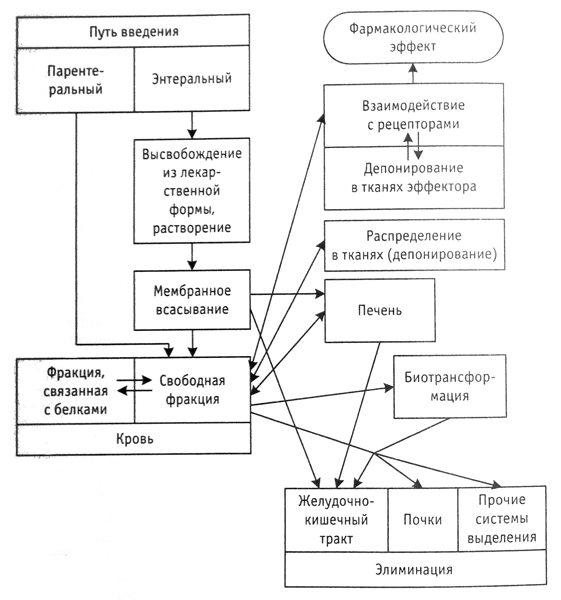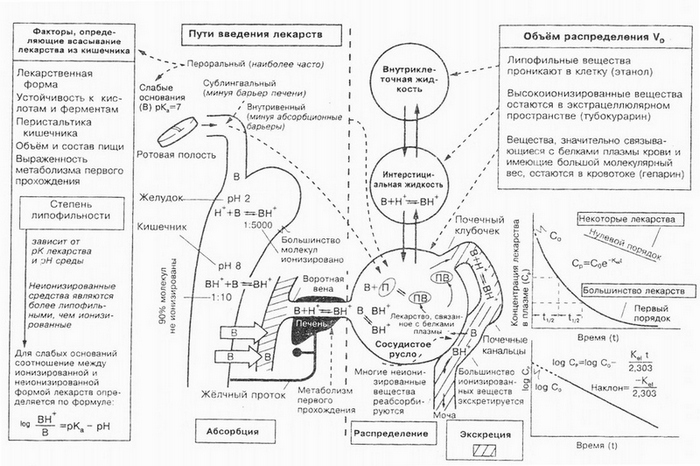Pharmacokinetic parameters – Required components of the concept of optimal drug therapy
Pharmacokinetics - Section of Pharmacology, to study the process of absorption, distribution, metabolism and excretion of drugs from the body.
When under the influence of the drug varies the concentration of other substances in the blood or its metabolite, This phenomenon is called Pharmacokinetic interactions.
Basic principles of pharmacokinetics is used in medical practice to develop a strategy and tactics of treatment of diseases with medicine. Information about the pharmacokinetics of drugs to determine the optimal way to allow their introduction, dosage, mode of application and duration, as well as other parameters, characteristics required for optimal pharmacotherapy - efficiency, tolerance, the presence of adverse events, the need for treatment and correction of t. d.
By the processes, who studies the pharmacokinetics, carry:
- release of drugs from drug;
- absorption of drugs - penetration through biological membranes in a biofluid, organs and tissues of the body;
- the distribution of drugs in the body;
- biotransformation of drugs, including biochemical transformations and the formation of metabolites;
- elimination of drugs from the body, including physiological and biochemical processes
To carry out the optimal pharmacotherapy is very important to know the "destiny" of drugs, taking into account the processes, which happen to them after introduction into the body. Schematically, it can provide the following possible path of drug in the body.

A prerequisite of any absorption process of the drug substance is its release from the dosage form, which should be considered as an initial, but the main component removals. So, eg, absorption of substances from tablets is limited by the process of release, depending on tablet disintegration and dissolution. In turn, dissolution rate affect the size and shape of the crystals of a drug substance, the number and nature of different adjuvants, moisture content of the tablet, processing parameters of pressing and other indicators.
The rate and completeness of drug absorption is significantly affected by the time of his stay in the digestive tract, where it is in various ways (passive diffusion, active transport, filtering, pinocytosis) penetrates biomembranes (epithelial, or endothelial cells, or target cells) and enters the biofluid. In spite of the general patterns of absorption of drugs in the body, There are a number of features of the kinetics of their admission into the blood when neroralnom, sublingual, rektalynom and parenteralynom (extravascular) route of administration, which also need to be considered.
An important place in the pharmacotherapy given to the stage of distribution of drugs in the body, as can be seen in the picture, which shows a general scheme of the suction, distribution and excretion of medicinal substances.

Since the place of localization of infectious agents in most cases are the intercellular spaces or cells of organs and tissues, this is where you need to create such a concentration of the drug, which would provide a therapeutic effect (inhibited the growth of bacteria and viruses) and at the same time it does not have a toxic effect on the body.
To ensure the concentration of drugs in tissues and organs of the body affected:
- value of the substance concentration in the blood;
- their interaction (binding) with protein components of blood, components intercellular spaces and cytoplasm of target cells;
- the ability to penetrate through various biomembrane and biobarery;
- the rate of blood flow in the tissues;
- pathological conditions and other factors.
Being in the body, Most drugs undergo biochemical transformations (biotransformation, metabolism), leading to changes in their primary structure. The result is a therapeutically inactive, indifferent or toxic products, metabolites. Restructuring substances causes a change not only their therapeutic efficacy, and properties. Metaʙolitы, Due to the large number of hydrophilic groups, more soluble, rapidly excreted.
At the heart of metabolism of drugs is a lot of specific biochemical reactions, controlled by a specific set of enzymes and co-enzymes, whose functions are reduced to reamination, decarboxylation, Racemization, pyeryenosu alidyegidnoi, acyl and other groups. On the metabolic processes of drugs can affect a variety of factors, including a pathological condition of the body.
Factors, influencing the metabolism of drugs
| ||
| № p / p | Factor | The nature and the result of interaction |
| 1 | Age (newborns, seniors) | Reducing the rate of metabolism |
| 2 | Pregnancy | Increased metabolic rate |
| 3 | Genetic factors | A variety of reactions |
| 4 | Liver disease | Reducing the rate of excretion of medicinal substances according to their kinetics, the type and stage of liver disease, increase bioavailability and reduced clearance rate |
| 5 | Diseases of the digestive tract | Changes in metabolism in the epithelium of the digestive tract |
| 6 | The nature of power:
| |
| a diet with a predominance of proteins over carbohydrates | Increased rate of metabolism of some drugs | |
| in severe eating disorders | Reducing the rate of metabolism | |
| 7 | External environment: | |
| Contact with hlorirovannыmi insekticidami | Increased metabolic rate | |
| 8 | Alcohol: | |
| acute administration | Induction of enzyme systems. The weakening of the therapeutic effect | |
| frequent consumption | Inhibition of enzymes, metabolizing drugs. Strengthening their actions | |
| 9 | Smoking | Increased metabolism of some drugs (eg, teofillina) |
| 10 | The route of administration of the drug | Metabolism in the liver before entering the systemic circulation (the effect of the first passage) after oral administration of drugs |
| 11 | The timing of administration of drugs | Circadian changes in the metabolism of drugs |
| 12 | Interaction of drugs | Stimulation and inhibition of enzymatic reactions |
The drugs and their metabolites are excreted (excrete) using different mechanisms via the kidneys, digestive organs, lungs, skin, with a secret sweat, plaintive, salivary and mammary glands.
The main ways of removing drugs from the body
| ||
The path clearance | Inference engine | The drugs |
| The urine | Glomerular filtration rate, active tubular secretion | Most of the drugs in the free (unbound)form |
| With the bile | Active Transportation, passive diffusion | Digitoxine, antibiotics (lenitsilliny, tetracikliny, Streptomycin), quinones, strychnine, quaternary ammonium compounds |
| Through the intestine | Passive diffusion and biliary secretion | Doxycycline, ionized organic acids |
| Saliva | The passive diffusion and active transport | Penicillin, sulfonamides, salicilaty, benzodiazepines, thiamine, ethanol |
| Through light | Passive diffusion | Inhaled anesthetics, yodydы, kamfora, ethanol, essential oils |
| Since then | Passive diffusion | Some sulfonamides, thiamine |
| With the mother's milk | The passive diffusion and active transport | Antykoahulyantы, antibiotics, thyreostatics, lithium, Carbamazepine |
Process excretion of medicinal substances is also affected the pharmacokinetic parameters of Pharmacotherapy. It should be emphasized the influence on the kinetics of drugs pathological conditions in human organs, especially kidneys, gastrointestinal tract, liver and biliary tract, Respiratory, which output the vast number of substances. Wherein, the larger the proportion of the body takes in the overall elimination of the drug from the body, the more his influence changed pharmacokinetics. Accounting pharmacokinetic parameters to optimize drug therapy and avoid adverse reactions (especially overdoses). Therefore, the pharmacokinetics of the substance is considered as a quantitative characteristic, affecting the qualitative aspect of pharmacological response.
In clinical pharmacokinetic studies are needed in low-dose effects of conventional therapy, the manifestation of symptoms of intoxication on the background of the destination medium therapeutic doses, sudden shifts of blood protein, as well as in the pathology systems, responsible for the absorption, metabolism and elimination of drugs. When solving applied problems, usually, unregistering limited drug concentration in the blood, its distribution in tissues of major organs and the definition of half-life of the substance from the serum without the involvement of mathematical modeling. It should be noted the importance of carrying out comprehensive studies pharmacokinetic and pharmacodynamic characteristics of the introduction into medical practice of new drugs, especially the group of cardiac glycosides.
| Influence of renal function on the elimination half (T1 / 2) certain antibiotics and synthetic antibacterial substances
| ||
Drug substance | T1 / 2, BUT | |
| In patients with normal renal function | In patients with creatine clearance below 30 ml / min. | |
Penicillin | ||
| Azloцillin | 0,9-1,3 | 5-8 |
| Amoksiцillin | 0,9-1,5 | 5-8 |
| Ampicillin | 1,3 | 13-20 |
| Benzilpenicillin | 0,5 | 7-10 |
| Dikloksacillin | 0,7-1 | 2 |
| Karbenicillin | 0,7 | 10 |
| Kloksaцillin | 0,5 | 2,2 |
| Oxacillin | 0,5 | 2 |
| Tikarцillin | 1-1,5 | 10 |
| Flukloksaцillin | 0,9-1,2 | 2,3 |
Cephalosporins | ||
| Moxalactam | 2-4 | 8-29 |
| Tseporyn | 1,8 | 10 |
| Tsefazolyn | 1,6 | to 115 |
| Cefaclor | 0,5-0,8 | 1,5-3,5 |
| Cephalexin | 1-1,5 | 10 |
| Tsefalotin | 0,65 | 5 |
| Цefamandol | 1,5 | 6,6 |
| Цefapirin | 0,5-1 | 3 |
| Tsefoksytyn | 0,6 | 7-23 |
| Cefotaxime | 0,9-1 | 3-10 |
| Tseftezol | 0,6 | 8-11 |
| Cefuroxime | 1,7 | 18 |
Aminoglikozidy | ||
| Amikacin | 1,7-1,9 | 15-150 |
| Gentamicin | 1-5 | 10-70 |
| Kanamycin | 3 | 24-96 |
| Sisomicin | 2,2-3,5 | 15-57 |
| Tobramycin | 3,5 | 14-70 |
| Streptomycin | 2,4-2,7 | 52-100 |
Tetracikliny | ||
| Doxycycline | 13,8-16,3 | 15-30 |
| Oxytetracycline | 8-9 | 48-66 |
| Tetracycline | 8,5 | 57-108 |
| Chlortetetracyclinium | 5,6 | 6,8-11 |
Other antibiotics | ||
| Amphotericin B | 24 | 24 and more |
| Vancomycin | 6-8 | 120-216 |
| Klindamiцin | 2,3-8,6 | 2,8-8,6 |
| Lincomycin | 4,4-4,7 | 10-13 |
| Polymyxin B | 6 | 48-72 |
| Fosfomycin | 2 | 7-11 |
| Chloramphenicol | 1,5-3,5 | 3-4,5 |
| Erythromycin | 1,4 | 5-6 |
Synthetic materials | ||
| 5-ftortsitozin | 3 | 85 |
| Isoniazid | 0,5-1,5 | 4,5 |
| Metronidazol | 6-14 | 8-15 |
| Mikonazol | 24 | 24 |
| Nalidixic acid | 1,5 | 21 |
| Nitrofurantoin | 0,5 | 0,5-1 |
| PAS | 0,85 | 5,1 |
| Sulfamethoxazole | 9-11 | 15 and more |
| Sulifizoksazol | 5-7 | 10 and more |
| Trimethoprim | 8-15 | 23 |
| Ethambutol | 2,5-4 | 7-8 |
